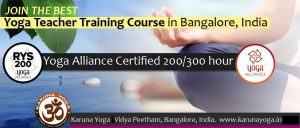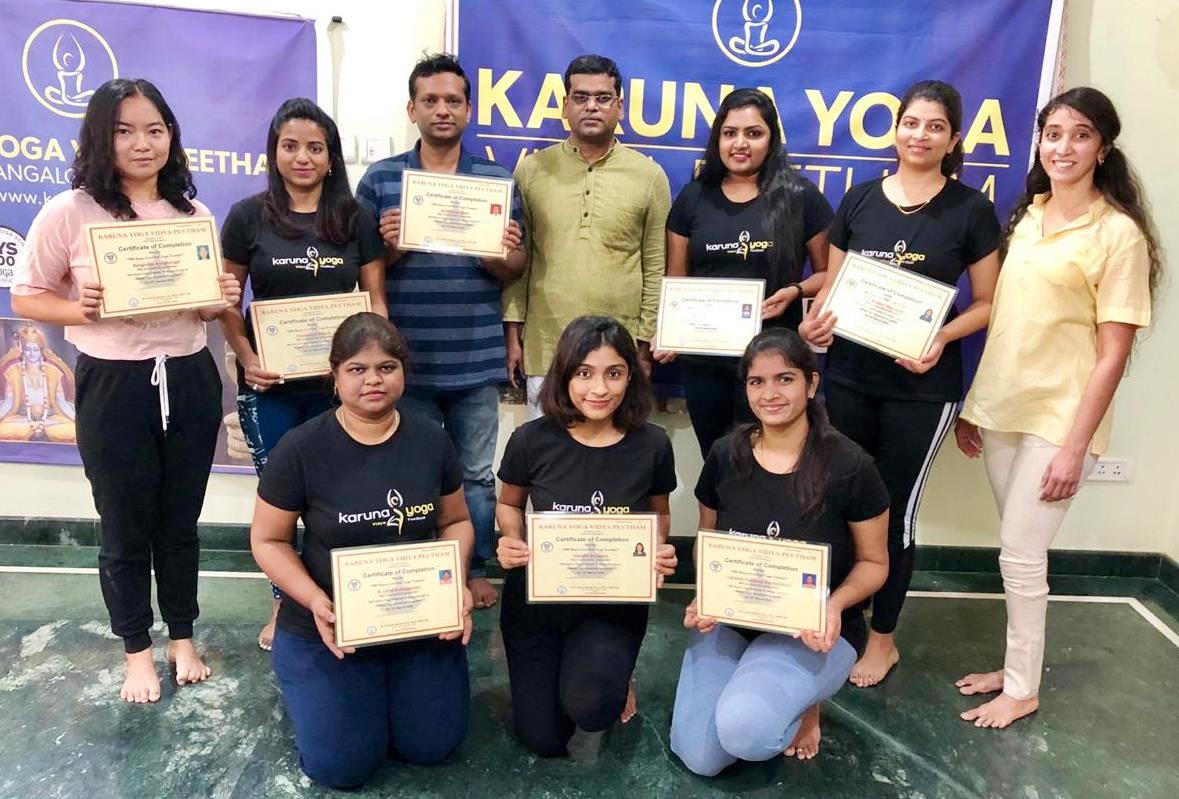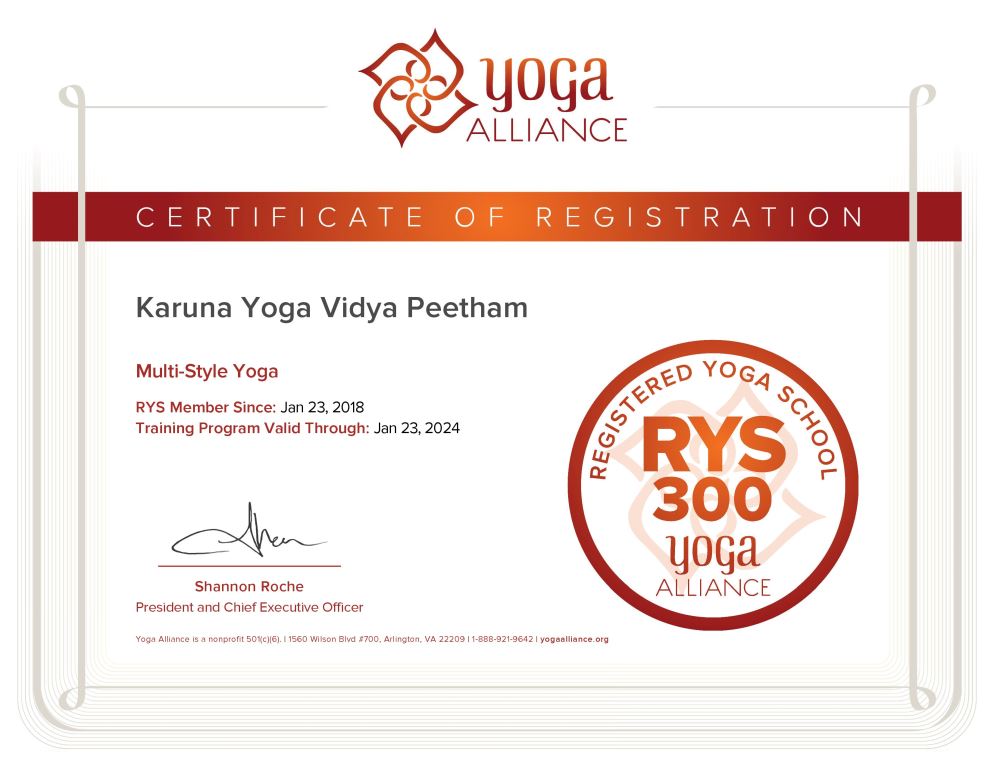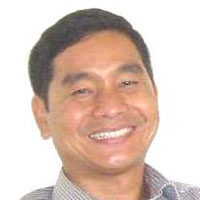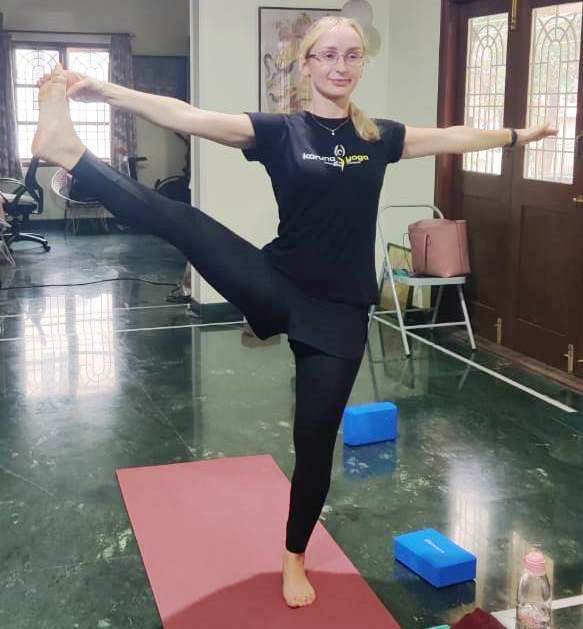
Menu
Close
- Home
- About Us
- Our Team
- What is Karuna Yoga?
- Karuna Yoga
- Dr. S. Karuna Murthy
- Yoga Medical Fitness Certificate
- Our Accreditation with Yoga Alliance
- PROJECT WORK – TTC STUDENT’S
- Yoga Question and Answer
- Karuna Yoga Question Bank
- Yoga Recommended Book
- asana gallery
- How to Affiliate with Karuna Yoga Vidya Peetham
- KARUNA YOGA VIDYA PEETHAM
- Travel Tips to Bangalore, India
- Review
- How to Register with Yoga Alliance : Step-by-Step Instructions for Teachers
- Managing Committee
- Founder & Director
- Student Assessment – Teacher Training Certificate Course
- How to Register with Yoga Alliance
- FAQ
- Project Work – Guidelines
- Associate Institutions
- Gallery
- Reg.
- Payment Options
- TTC Registration
- Registration Short Course
- Yoga Health Form
- Terms & Conditions
- Admission Process
- Refund & Cancellation Policy
- Grievance Policy – Karuna Yoga Vidya Peetham
- Anti-Harassment/Sexual Misconduct Policy
- Code Of Conduct – Karuna Yoga Vidya Peetham
- Rules and Regulations
- Eligibility Criteria
- Admission Rules and Regulations
- 200 Hr TTC
- ATTC
- Yoga Foundation Certification Course (YFC) Level – 1
- RYT – 300 Hr Yoga ATTC Level – 2
- RYT – 500 Hr Yoga ATTC
- ATTC – 800 Hr Advanced Yoga Teacher Training Certificate Course, Bangalore, India.
- TTC – 100 Hr Yoga Teacher TrainingYUUI
- TTC – 50 Hr
- Yoga Therapy Online/Offline
- Yoga for Anxiety & Depression Course
- Yoga for Digestive System Certificate Course
- Yoga for Arthritis Course
- 50 Hrs – Yoga for Asthma & Respiratory Disorder Teacher Training Certificate Course, Bangalore, India.
- 50 Hrs – Yoga for Hypertension Teacher Training Certificate Course, Bangalore, India.
- 50 Hrs – Yoga for Back Pain Teacher Training Certificate Course, Bangalore, India.
- 50 Hr - Hatha-Vinyasa Yoga TTC
- 50 Hr - Restorative Yoga TTC
- 50 Hr - Vinyasa Yoga TTC
- 50 Hr - Ashtanga Yoga TTC
- 50 Hr - Yin Yoga Teacher TTC
- 50 Hr - Yin Yoga & Meditation TTC
- 50 Hr - Vinyasa-Hatha Yoga TTC
- 50 Hr-Psychotherapeutic TTC
- 50 Hr-Trauma, Depression & Anxiety TTC
- 50 Hr - Somatic Yoga TTC
- 50 Hr - Yoga Mentorship TTC
- 50 Hr-Partner & Couple Yoga TTC
- 50 Hr-Breathwork&Pranayama
- 50 Hr - Yoga Internship TTC
- 100 Hr - Yoga Therapist TTC
- 50 Hr - Anxiety & Depression TTC
- 50 Hr - Digestive System TTC
- 50 Hr - Arthritis TTC
- 50 Hr - Asthma TTC
- 50 Hr - Hypertension TTC
- 50 Hr - Back Pain TTC
- 50 Hr - Diabetes Mellitus TTC
- 30 Hr - Mudra Therapy TTC
- 50 Hr- Emotional Management
- 30 Hr - Corporate Yoga TTC
- 50 Hr - Yoga Therapist TTC
- 50 Hr – Yoga Therapy TTC
- 100 Hrs Prenatal & Postnatal TTC
- 100 Hrs – Kids & Teen Yoga TTC
- 100 Hrs – Gentle Yoga TTC
- 100 Hrs - Somatic & Yin Yoga TTC
- 100 Hrs – Yoga Course TTC
- 100 Hrs – Mudra & Bandha TTC
- 100 Hr-Asana, Pranayama, Mudra & Bandha
- 100 Hr - Restorative Yoga TTC
- 100 Hr - Yin Yoga TTC
- 100 Hr - Vinyasa Yoga TTC
- 100 Hr - Hatha-Vinyasa Yoga TTC
- ON DEMAND
- Short Term -1
- Beginners Yoga Course
- 30 Hrs – Hatha Yoga Teacher Training Certificate Course, Bangalore, India.
- Yoga Philosophy Course
- 50 Hrs – Yoga Mantra Chanting Certificate Course, Bangalore, India.
- Asana, Pranayama, Mudra, and Bandha Course
- 30 Hrs – Yoga Pranic Energization Technique (PET) Teacher Training Certification Course, Bangalore, India.
- 50 Hrs – Yoga Nidra Teacher Training Certification Course: The Art of Relaxation
- SMET (Self-Management of Excessive Tension) Certificate Course
- 50 Hrs – Meditation Teacher Training Certificate Course, Bangalore, India
- Yoga for Beginner’s Course
- 30 Hr – Trataka & Meditation Teacher Training Certificate Course, Bangalore, India.
- 30 Hrs – Shat-Karma (Detoxification Course) & Pranayama Teacher Training Certification Course, Bangalore, India.
- Yogic Suksma Vyayama
- 50 Hrs – Pranayama, Mudra, Bandha & Meditation Teacher Training Certificate Course, Bangalore, India.
- Yoga, Anatomy & Physiology Course
- 50 Hrs Mantra Chanting
- Mudra & Pranayama Course
- 50 Hrs – Pranayama Teacher Training Certificate Course, Bangalore, India
- 50 Hrs – Mudra Teacher Training Certificate Course, Bangalore, India.
- Pranayama Teacher Training
- Patanjali Yoga Sutra Course
- Advanced Level
- Yoga Class Sequencing Teacher Training
- 50 Hrs – Asana Adjustment & Alignment Yoga Teacher Training Certificate Course, Bangalore, India.
- 30 Hrs Backward Bending and Balancing Asana Certificate Course
- 30 Hrs – Yoga Teaching, Training and Techniques Certificate Course, Bangalore, India.
- Asana and Kinesiology Teacher Training
- 50 Hrs – Yoga Techniques & Teaching Methodology Teacher Training Certificate Course, Bangalore, India.
- Asana and Bio-Mechanism Teacher Training
- 30 Hrs – Asana Alignment & Verbal Cues Teacher Training Certificate Course, Bangalore, India.
- Asana & Alignment Certificate Course
- 50 Hrs – Mudra Yoga TTC
- 50 Hr - Beginner’s Yoga TTC
- 50 Hr - Hatha Yoga TTC
- 30 Hr-Yoga Philosophy Lifestyle TTC
- 50 Hr - Asana, Pranayama, Mudra & Bandha TTC
- 30 Hr-Pranic Energization Technique
- 50 Hr - Yoga Nidra TTC
- 30 Hr - Cylic Meditation TTC
- 30 Hr-Mind Sound Resonance Tech. (MSRT)
- 50 Hr - Meditation & Yoga Nidra TTC
- 30 Hr-Biomechanics & Alignments of Sun Salutations
- 50 Hrs Advanced Mantra Chanting
- 30 Hr-Sanskrit Mantra Chanting TTC
- 50 Hr- Mudra Therapy TTC
- 30 Hr-Trataka & Meditation TTC
- 30 Hr-ShatKarma & Pranayama TTC
- 50 Hr - Yogic Suksma Vyayama TTC
- 50 Hr- Pranayama, Mudra, Bandha & Meditation
- 50 Hr-Yoga, Anatomy & Physiology TTC
- 50 Hr - Mudra & Pranayama TTC
- 50 Hr - Pranayama TTC
- 30 Hr - Patanjali Yoga Sutra TTC
- 50 Hr - Meditation TTC
- 50 Hr-Pranayama & Meditation TTC
- 30 Hr-SMET(Self-Management of Excessive Tension)
- 50 Hr - Anatomy of Yoga Breathing
- 50 Hr -Asana Adjustment Alignment
- 30 Hr-Backward Bending TTC
- 30 Hr-Teaching, Training & Techniques
- 30 Hr - Asana & Kinesiology TTC
- 50 Hr-Techniques&Teaching Methodology
- 30 Hr - Asana & Bio-Mechanism TTC
- 30 Hr- Asana Alignment & Verbal Cues TTC
- 50 Hr - Kinesiology & Yoga TTC
- 50 Hr - Mudra & Mantra Chanting TTC
- 30 Hr - Complete Eye Yoga TTC
- Ashtanga Yoga Sutra Philosophy & Chanting
- Short Term -1
- YACEP
- 50 Hrs – Kriya Pranayama Teacher Training Certificate Course
- 200 Hrs – Hatha-Vinyasa TTC
- 50 Hrs – Senior’s & Geriatric Yoga Teacher Training Certificate Course
- 200 Hrs – Hatha Yoga TTC
- 1OO Hr – Mudra Therapy TTC tripanee
- 1OO Hr – Yoga Nidra & Meditation TTC
- 50 Hrs – Yoga Philosophy, Lifestyle & Ethics Yoga Teacher Training Certificate Course, Bangalore, India.
- 50 Hrs – Yoga Mantra Chanting Certificate Course, Bangalore, India.
- Yoga Life Coach TTC
- 2OO Hr – Week-End TTC
- 100 Hrs – Asana Teacher Training Certificate Course, Bangalore, India.
- Self-Paced 200-Hrs TTC
- 100 Hrs – Pranayama & Meditation TTC
- 100 Hrs – Mudra & Mantra Chanting TTC
- 100 Hrs – Meditation TTC
- 100 Hrs – Mudra & Pranayama TTC
- 100 Hrs – Pranayama Teacher Training Certificate Course, Bangalore, India.
- 100 Hrs – Meditation & Yoga Nidra Teacher Training Certificate Course, Bangalore, India.
- 100 Hrs – Yoga Nidra Teacher Training Certification Course, Bangalore, India
- 100 Hrs – Pranayama, Mudra, Bandha & Meditation Teacher Training Certificate Course, Bangalore, India.
- 100 Hrs – Mudra Teacher Training Certificate Course, Bangalore, India.
- 100 Hr – Hatha Vinyasa & Kids Yoga Teacher Training Course (TTC)
- 100-Hr Prenatal Yoga & Mudra Therapy TTC
- 100-Hour Kids and Prenatal Yoga Teacher Training Course (TTC)
- 100-Hr Yin & Prenatal TTC
- 100-Hr Hatha-Vinyasa Yoga & Prenatal TTC
- 100-Hr Hatha Yoga & Mentorship TTC
- 100-Hr Kids and Prenatal Yoga TTC
- 100-Hr Yin Yoga, Anatomy, Physiology, and Kinesiology TTC
- 100-Hr Prenatal Yoga and Yoga Therapy TTC
- 100 Hr – Hatha Vinyasa & Kids Yoga Teacher Training Course (TTC)
- 100-Hr Yin & Prenatal TTC
- 50 Hrs – Meditation, Yoga Nidra, Breathe Work & Pranayama Teacher Training Certificate Course
- 200Hr – Hatha Yoga and Yoga Therapy Teacher Training Course (TTC)
- 100-Hr Prenatal Yoga & Mudra Therapy TTC
- 50 Hrs - Yoga for Cancer
- 50 Hr - Breathwork TTC
- 50 Hrs - Kriya Pranayama
- 200 Hrs – Hatha-Vinyasa
- 50 Hr Senior’s & Geriatric TTC
- 200 Hrs - Hatha Yoga TTC
- 200 Hrs - Vinyasa Yoga TTC
- 1OO Hr - Yoga Nidra & Meditation TTC
- 200 Hrs Yin Yoga TTC
- 50 Hrs – Yoga Philosophy, Lifestyle & Ethics
- 100 Hrs - Asana TTC
- Self-Paced 200-Hrs TTC
- 100 Hrs – Pranayama & Meditation TTC
- 100 Hrs – Mudra & Mantra Chanting TTC
- 100 Hrs – Meditation & Yoga Nidra TTC
- 200-Hour Ashtanga, Vinyasa, Anatomy, Physiology & Kinesiology TTC
- 100 Hrs - Meditation TTC
- 100 Hrs - Mudra & Pranayama TTC
- 100 Hrs - Pranayama TTC
- 100-Hr Prenatal Yoga & Mudra Therapy TTC
- 200 Hr-Hatha, Astanga, Vinyasa, Anatomy Physiology, & Kinesiology TTC
- 200Hr – Hatha Yoga and Yoga Therapy TTC
- 200 Hr – Hatha, Vinyasa, Yin & Yoga Therapy
- 200 Hr – Hatha, Vinyasa, Ashtanga & Restorative Yoga TTC
- 50 Hrs – Meditation, Yoga Nidra, Breathe Work & Pranayama TTC
- 200 Hr – Hatha, Vinyasa, Yin Yoga, Anatomy, Physiology & Kinesiology TTC
- 100-Hr Yin & Prenatal TTC
- 100 Hr – Hatha Vinyasa & Kids TTC
- 100-Hr Prenatal Yoga and Yoga Therapy TTC
- 100-Hr Yin Yoga, Anatomy, Physiology, and Kinesiology TTC
- 200-Hr Hatha, Vinyasa, Yoga Therapy & Prenatal TTC
- 100-Hr Kids and Prenatal Yoga TTC
- 100-Hr Hatha Yoga & Mentorship TTC
- 100-Hr Hatha-Vinyasa Yoga & Prenatal TTC
- 100-Hr Yin & Prenatal TTC
- 100-Hour Kids and Prenatal
- 100-Hr Prenatal Yoga & Mudra Therapy TTC
- 100 Hrs – Mudra TTC
- 100 Hrs – Pranayama, Mudra, Bandha & Meditation TTC
- 100 Hrs – Yoga Nidra TTC
- Online
- Online Yoga Nidra TTC
- Online Mudra Therapy TTC
- Online Pranayama TTC
- 50 Hrs – Mudra, Mantra Chanting, & Somatic Yoga Teacher Training Course
- Online Meditation TTC
- Online Yin Yoga TTC
- Online Mantra Chanting
- Online Yoga Therapy Teacher Training Certificate Course
- Online Prenatal Yoga TTC
- Online Kids Yoga TTC
- Online 200 Hr Yoga TTC
- 50 Hrs – Seniors Yoga Teacher Training – Online/Offline
- 50 Hrs – Yoga for Cancer (Oncology Yoga) Teacher Training Certificate Course: Balancing Immune System
- Breathwork Teacher Training
- Seniors Chair Yoga Teacher Training – Online/Offline
- Retreat
- Blog
- Contact
- Chennai
- Mysore
- Pondicherry
- Yoga for Digestive System – tripanee
- Yoga for Diabetes Mellitus Course – trip
- Yoga for Arthritis – tripanee
- Yoga for Respiratory Ailments – tripanee
- Yoga for Back Pain – Tripanee
- Yoga for Hypertension and Heart Diseases – tripanee
- Yoga for Anxiety & Depression – Tripanee
- Yogic Suksma Vyayama – tripanee
- Tripaneer
- Mudra & Bandha Certificate Course
- Patanjali Yoga Sutra Course – Tripanee
- Asana, Pranayama, Mudra, and Bandha – Tripanee
- Kinesiology and Yoga Teacher Training Course – Tripanee
- Yoga Mantra Chanting – Tripanee
- Asana and Bio-Mechanism -tripanee
- Yoga Philosophy Course – tripanee
- Pranayama & Meditation – Tripanee
- Self-Paced Online 200-Hr TTC – Tripaneer
- 200-Hour Online 30 Day Intensive TTC
- 200-Hour Online 20 Day High Intensive Yoga Teacher Training Certificate Course – Tripaneer
- 100 Hr – Yoga Therapy Teacher Training Certificate Course – Level – 1
- 100 Hr – Yoga Therapy Teacher Training Certificate Course – Level – 2
- Online Self-Paced 50 – Yin Yoga Teacher Training Certificate Course – trip
- Online Self-Paced 50 Hr – Restorative Yoga Teacher Training Certificate Course
- 100 Hr – Online Hatha-Vinyasa Yoga
- 100 Hours Online – Vinyasa Yoga
- 100 Hours Offline/Online – Ashtanga Yoga Teacher Training Certificate Course
- 50 Hr Online – Hatha Yoga Teacher Training Course
- Self-paced Online 300-Hour Yoga Teacher Training Certificate Course – trip
- 500 Hr ATTC
- 50 hours Online – Hatha-Vinyasa
- 10 Hrs- Mudra & Bandha - tripanee
- 12 Hr – Patanjali Yoga Sutra Course – Tripanee
- 10-Hr Asana, Pranayama, Mudra, & Bandha-tripanee
- 10-Hr Kinesiology & Yoga - Tripanee
- 10 Hr Yoga Mantra Chanting-tripanee
- 10 Hr Asana & Bio-Mechanism - tripanee
- 10-Hr Yoga Philosophy - tripanee
- 12 Hr – Pranayama & Meditation-trip
- 200-Hr TTC – Tripaneer
- 200-Hour 30 Day TTC - trip
- 200-Hr 20 Day TTC – Tripaneer
- 100 Hr – Yoga Therapy – Level – 1 trip
- 100 Hr – Yoga Therapy Level – 2 - trip
- 50hr – Yin Yoga - trip
- 50 Hr – Restorative Yoga -trip
- 100 Hr – Hatha-Vinyasa TTC - trip
- 100 Hr Vinyasa Yoga - trip
- 100 Hr – Ashtanga Yoga -trip
- 50 Hr Hatha Yoga -trip
- 300-Hr Yoga TTC – trip
- 500 Hr ATTC-trip
- 50 hr – Hatha-Vinyasa -trip
- Home
- About Us
- Our Team
- What is Karuna Yoga?
- Karuna Yoga
- Dr. S. Karuna Murthy
- Yoga Medical Fitness Certificate
- Our Accreditation with Yoga Alliance
- PROJECT WORK – TTC STUDENT’S
- Yoga Question and Answer
- Karuna Yoga Question Bank
- Yoga Recommended Book
- asana gallery
- How to Affiliate with Karuna Yoga Vidya Peetham
- KARUNA YOGA VIDYA PEETHAM
- Travel Tips to Bangalore, India
- Review
- How to Register with Yoga Alliance : Step-by-Step Instructions for Teachers
- Managing Committee
- Founder & Director
- Student Assessment – Teacher Training Certificate Course
- How to Register with Yoga Alliance
- FAQ
- Project Work – Guidelines
- Associate Institutions
- Gallery
- Reg.
- Payment Options
- TTC Registration
- Registration Short Course
- Yoga Health Form
- Terms & Conditions
- Admission Process
- Refund & Cancellation Policy
- Grievance Policy – Karuna Yoga Vidya Peetham
- Anti-Harassment/Sexual Misconduct Policy
- Code Of Conduct – Karuna Yoga Vidya Peetham
- Rules and Regulations
- Eligibility Criteria
- Admission Rules and Regulations
- 200 Hr TTC
- ATTC
- Yoga Foundation Certification Course (YFC) Level – 1
- RYT – 300 Hr Yoga ATTC Level – 2
- RYT – 500 Hr Yoga ATTC
- ATTC – 800 Hr Advanced Yoga Teacher Training Certificate Course, Bangalore, India.
- TTC – 100 Hr Yoga Teacher TrainingYUUI
- TTC – 50 Hr
- Yoga Therapy Online/Offline
- Yoga for Anxiety & Depression Course
- Yoga for Digestive System Certificate Course
- Yoga for Arthritis Course
- 50 Hrs – Yoga for Asthma & Respiratory Disorder Teacher Training Certificate Course, Bangalore, India.
- 50 Hrs – Yoga for Hypertension Teacher Training Certificate Course, Bangalore, India.
- 50 Hrs – Yoga for Back Pain Teacher Training Certificate Course, Bangalore, India.
- 50 Hr - Hatha-Vinyasa Yoga TTC
- 50 Hr - Restorative Yoga TTC
- 50 Hr - Vinyasa Yoga TTC
- 50 Hr - Ashtanga Yoga TTC
- 50 Hr - Yin Yoga Teacher TTC
- 50 Hr - Yin Yoga & Meditation TTC
- 50 Hr - Vinyasa-Hatha Yoga TTC
- 50 Hr-Psychotherapeutic TTC
- 50 Hr-Trauma, Depression & Anxiety TTC
- 50 Hr - Somatic Yoga TTC
- 50 Hr - Yoga Mentorship TTC
- 50 Hr-Partner & Couple Yoga TTC
- 50 Hr-Breathwork&Pranayama
- 50 Hr - Yoga Internship TTC
- 100 Hr - Yoga Therapist TTC
- 50 Hr - Anxiety & Depression TTC
- 50 Hr - Digestive System TTC
- 50 Hr - Arthritis TTC
- 50 Hr - Asthma TTC
- 50 Hr - Hypertension TTC
- 50 Hr - Back Pain TTC
- 50 Hr - Diabetes Mellitus TTC
- 30 Hr - Mudra Therapy TTC
- 50 Hr- Emotional Management
- 30 Hr - Corporate Yoga TTC
- 50 Hr - Yoga Therapist TTC
- 50 Hr – Yoga Therapy TTC
- 100 Hrs Prenatal & Postnatal TTC
- 100 Hrs – Kids & Teen Yoga TTC
- 100 Hrs – Gentle Yoga TTC
- 100 Hrs - Somatic & Yin Yoga TTC
- 100 Hrs – Yoga Course TTC
- 100 Hrs – Mudra & Bandha TTC
- 100 Hr-Asana, Pranayama, Mudra & Bandha
- 100 Hr - Restorative Yoga TTC
- 100 Hr - Yin Yoga TTC
- 100 Hr - Vinyasa Yoga TTC
- 100 Hr - Hatha-Vinyasa Yoga TTC
- ON DEMAND
- Short Term -1
- Beginners Yoga Course
- 30 Hrs – Hatha Yoga Teacher Training Certificate Course, Bangalore, India.
- Yoga Philosophy Course
- 50 Hrs – Yoga Mantra Chanting Certificate Course, Bangalore, India.
- Asana, Pranayama, Mudra, and Bandha Course
- 30 Hrs – Yoga Pranic Energization Technique (PET) Teacher Training Certification Course, Bangalore, India.
- 50 Hrs – Yoga Nidra Teacher Training Certification Course: The Art of Relaxation
- SMET (Self-Management of Excessive Tension) Certificate Course
- 50 Hrs – Meditation Teacher Training Certificate Course, Bangalore, India
- Yoga for Beginner’s Course
- 30 Hr – Trataka & Meditation Teacher Training Certificate Course, Bangalore, India.
- 30 Hrs – Shat-Karma (Detoxification Course) & Pranayama Teacher Training Certification Course, Bangalore, India.
- Yogic Suksma Vyayama
- 50 Hrs – Pranayama, Mudra, Bandha & Meditation Teacher Training Certificate Course, Bangalore, India.
- Yoga, Anatomy & Physiology Course
- 50 Hrs Mantra Chanting
- Mudra & Pranayama Course
- 50 Hrs – Pranayama Teacher Training Certificate Course, Bangalore, India
- 50 Hrs – Mudra Teacher Training Certificate Course, Bangalore, India.
- Pranayama Teacher Training
- Patanjali Yoga Sutra Course
- Advanced Level
- Yoga Class Sequencing Teacher Training
- 50 Hrs – Asana Adjustment & Alignment Yoga Teacher Training Certificate Course, Bangalore, India.
- 30 Hrs Backward Bending and Balancing Asana Certificate Course
- 30 Hrs – Yoga Teaching, Training and Techniques Certificate Course, Bangalore, India.
- Asana and Kinesiology Teacher Training
- 50 Hrs – Yoga Techniques & Teaching Methodology Teacher Training Certificate Course, Bangalore, India.
- Asana and Bio-Mechanism Teacher Training
- 30 Hrs – Asana Alignment & Verbal Cues Teacher Training Certificate Course, Bangalore, India.
- Asana & Alignment Certificate Course
- 50 Hrs – Mudra Yoga TTC
- 50 Hr - Beginner’s Yoga TTC
- 50 Hr - Hatha Yoga TTC
- 30 Hr-Yoga Philosophy Lifestyle TTC
- 50 Hr - Asana, Pranayama, Mudra & Bandha TTC
- 30 Hr-Pranic Energization Technique
- 50 Hr - Yoga Nidra TTC
- 30 Hr - Cylic Meditation TTC
- 30 Hr-Mind Sound Resonance Tech. (MSRT)
- 50 Hr - Meditation & Yoga Nidra TTC
- 30 Hr-Biomechanics & Alignments of Sun Salutations
- 50 Hrs Advanced Mantra Chanting
- 30 Hr-Sanskrit Mantra Chanting TTC
- 50 Hr- Mudra Therapy TTC
- 30 Hr-Trataka & Meditation TTC
- 30 Hr-ShatKarma & Pranayama TTC
- 50 Hr - Yogic Suksma Vyayama TTC
- 50 Hr- Pranayama, Mudra, Bandha & Meditation
- 50 Hr-Yoga, Anatomy & Physiology TTC
- 50 Hr - Mudra & Pranayama TTC
- 50 Hr - Pranayama TTC
- 30 Hr - Patanjali Yoga Sutra TTC
- 50 Hr - Meditation TTC
- 50 Hr-Pranayama & Meditation TTC
- 30 Hr-SMET(Self-Management of Excessive Tension)
- 50 Hr - Anatomy of Yoga Breathing
- 50 Hr -Asana Adjustment Alignment
- 30 Hr-Backward Bending TTC
- 30 Hr-Teaching, Training & Techniques
- 30 Hr - Asana & Kinesiology TTC
- 50 Hr-Techniques&Teaching Methodology
- 30 Hr - Asana & Bio-Mechanism TTC
- 30 Hr- Asana Alignment & Verbal Cues TTC
- 50 Hr - Kinesiology & Yoga TTC
- 50 Hr - Mudra & Mantra Chanting TTC
- 30 Hr - Complete Eye Yoga TTC
- Ashtanga Yoga Sutra Philosophy & Chanting
- Short Term -1
- YACEP
- 50 Hrs – Kriya Pranayama Teacher Training Certificate Course
- 200 Hrs – Hatha-Vinyasa TTC
- 50 Hrs – Senior’s & Geriatric Yoga Teacher Training Certificate Course
- 200 Hrs – Hatha Yoga TTC
- 1OO Hr – Mudra Therapy TTC tripanee
- 1OO Hr – Yoga Nidra & Meditation TTC
- 50 Hrs – Yoga Philosophy, Lifestyle & Ethics Yoga Teacher Training Certificate Course, Bangalore, India.
- 50 Hrs – Yoga Mantra Chanting Certificate Course, Bangalore, India.
- Yoga Life Coach TTC
- 2OO Hr – Week-End TTC
- 100 Hrs – Asana Teacher Training Certificate Course, Bangalore, India.
- Self-Paced 200-Hrs TTC
- 100 Hrs – Pranayama & Meditation TTC
- 100 Hrs – Mudra & Mantra Chanting TTC
- 100 Hrs – Meditation TTC
- 100 Hrs – Mudra & Pranayama TTC
- 100 Hrs – Pranayama Teacher Training Certificate Course, Bangalore, India.
- 100 Hrs – Meditation & Yoga Nidra Teacher Training Certificate Course, Bangalore, India.
- 100 Hrs – Yoga Nidra Teacher Training Certification Course, Bangalore, India
- 100 Hrs – Pranayama, Mudra, Bandha & Meditation Teacher Training Certificate Course, Bangalore, India.
- 100 Hrs – Mudra Teacher Training Certificate Course, Bangalore, India.
- 100 Hr – Hatha Vinyasa & Kids Yoga Teacher Training Course (TTC)
- 100-Hr Prenatal Yoga & Mudra Therapy TTC
- 100-Hour Kids and Prenatal Yoga Teacher Training Course (TTC)
- 100-Hr Yin & Prenatal TTC
- 100-Hr Hatha-Vinyasa Yoga & Prenatal TTC
- 100-Hr Hatha Yoga & Mentorship TTC
- 100-Hr Kids and Prenatal Yoga TTC
- 100-Hr Yin Yoga, Anatomy, Physiology, and Kinesiology TTC
- 100-Hr Prenatal Yoga and Yoga Therapy TTC
- 100 Hr – Hatha Vinyasa & Kids Yoga Teacher Training Course (TTC)
- 100-Hr Yin & Prenatal TTC
- 50 Hrs – Meditation, Yoga Nidra, Breathe Work & Pranayama Teacher Training Certificate Course
- 200Hr – Hatha Yoga and Yoga Therapy Teacher Training Course (TTC)
- 100-Hr Prenatal Yoga & Mudra Therapy TTC
- 50 Hrs - Yoga for Cancer
- 50 Hr - Breathwork TTC
- 50 Hrs - Kriya Pranayama
- 200 Hrs – Hatha-Vinyasa
- 50 Hr Senior’s & Geriatric TTC
- 200 Hrs - Hatha Yoga TTC
- 200 Hrs - Vinyasa Yoga TTC
- 1OO Hr - Yoga Nidra & Meditation TTC
- 200 Hrs Yin Yoga TTC
- 50 Hrs – Yoga Philosophy, Lifestyle & Ethics
- 100 Hrs - Asana TTC
- Self-Paced 200-Hrs TTC
- 100 Hrs – Pranayama & Meditation TTC
- 100 Hrs – Mudra & Mantra Chanting TTC
- 100 Hrs – Meditation & Yoga Nidra TTC
- 200-Hour Ashtanga, Vinyasa, Anatomy, Physiology & Kinesiology TTC
- 100 Hrs - Meditation TTC
- 100 Hrs - Mudra & Pranayama TTC
- 100 Hrs - Pranayama TTC
- 100-Hr Prenatal Yoga & Mudra Therapy TTC
- 200 Hr-Hatha, Astanga, Vinyasa, Anatomy Physiology, & Kinesiology TTC
- 200Hr – Hatha Yoga and Yoga Therapy TTC
- 200 Hr – Hatha, Vinyasa, Yin & Yoga Therapy
- 200 Hr – Hatha, Vinyasa, Ashtanga & Restorative Yoga TTC
- 50 Hrs – Meditation, Yoga Nidra, Breathe Work & Pranayama TTC
- 200 Hr – Hatha, Vinyasa, Yin Yoga, Anatomy, Physiology & Kinesiology TTC
- 100-Hr Yin & Prenatal TTC
- 100 Hr – Hatha Vinyasa & Kids TTC
- 100-Hr Prenatal Yoga and Yoga Therapy TTC
- 100-Hr Yin Yoga, Anatomy, Physiology, and Kinesiology TTC
- 200-Hr Hatha, Vinyasa, Yoga Therapy & Prenatal TTC
- 100-Hr Kids and Prenatal Yoga TTC
- 100-Hr Hatha Yoga & Mentorship TTC
- 100-Hr Hatha-Vinyasa Yoga & Prenatal TTC
- 100-Hr Yin & Prenatal TTC
- 100-Hour Kids and Prenatal
- 100-Hr Prenatal Yoga & Mudra Therapy TTC
- 100 Hrs – Mudra TTC
- 100 Hrs – Pranayama, Mudra, Bandha & Meditation TTC
- 100 Hrs – Yoga Nidra TTC
- Online
- Online Yoga Nidra TTC
- Online Mudra Therapy TTC
- Online Pranayama TTC
- 50 Hrs – Mudra, Mantra Chanting, & Somatic Yoga Teacher Training Course
- Online Meditation TTC
- Online Yin Yoga TTC
- Online Mantra Chanting
- Online Yoga Therapy Teacher Training Certificate Course
- Online Prenatal Yoga TTC
- Online Kids Yoga TTC
- Online 200 Hr Yoga TTC
- 50 Hrs – Seniors Yoga Teacher Training – Online/Offline
- 50 Hrs – Yoga for Cancer (Oncology Yoga) Teacher Training Certificate Course: Balancing Immune System
- Breathwork Teacher Training
- Seniors Chair Yoga Teacher Training – Online/Offline
- Retreat
- Blog
- Contact
- Chennai
- Mysore
- Pondicherry
- Yoga for Digestive System – tripanee
- Yoga for Diabetes Mellitus Course – trip
- Yoga for Arthritis – tripanee
- Yoga for Respiratory Ailments – tripanee
- Yoga for Back Pain – Tripanee
- Yoga for Hypertension and Heart Diseases – tripanee
- Yoga for Anxiety & Depression – Tripanee
- Yogic Suksma Vyayama – tripanee
- Tripaneer
- Mudra & Bandha Certificate Course
- Patanjali Yoga Sutra Course – Tripanee
- Asana, Pranayama, Mudra, and Bandha – Tripanee
- Kinesiology and Yoga Teacher Training Course – Tripanee
- Yoga Mantra Chanting – Tripanee
- Asana and Bio-Mechanism -tripanee
- Yoga Philosophy Course – tripanee
- Pranayama & Meditation – Tripanee
- Self-Paced Online 200-Hr TTC – Tripaneer
- 200-Hour Online 30 Day Intensive TTC
- 200-Hour Online 20 Day High Intensive Yoga Teacher Training Certificate Course – Tripaneer
- 100 Hr – Yoga Therapy Teacher Training Certificate Course – Level – 1
- 100 Hr – Yoga Therapy Teacher Training Certificate Course – Level – 2
- Online Self-Paced 50 – Yin Yoga Teacher Training Certificate Course – trip
- Online Self-Paced 50 Hr – Restorative Yoga Teacher Training Certificate Course
- 100 Hr – Online Hatha-Vinyasa Yoga
- 100 Hours Online – Vinyasa Yoga
- 100 Hours Offline/Online – Ashtanga Yoga Teacher Training Certificate Course
- 50 Hr Online – Hatha Yoga Teacher Training Course
- Self-paced Online 300-Hour Yoga Teacher Training Certificate Course – trip
- 500 Hr ATTC
- 50 hours Online – Hatha-Vinyasa
- 10 Hrs- Mudra & Bandha - tripanee
- 12 Hr – Patanjali Yoga Sutra Course – Tripanee
- 10-Hr Asana, Pranayama, Mudra, & Bandha-tripanee
- 10-Hr Kinesiology & Yoga - Tripanee
- 10 Hr Yoga Mantra Chanting-tripanee
- 10 Hr Asana & Bio-Mechanism - tripanee
- 10-Hr Yoga Philosophy - tripanee
- 12 Hr – Pranayama & Meditation-trip
- 200-Hr TTC – Tripaneer
- 200-Hour 30 Day TTC - trip
- 200-Hr 20 Day TTC – Tripaneer
- 100 Hr – Yoga Therapy – Level – 1 trip
- 100 Hr – Yoga Therapy Level – 2 - trip
- 50hr – Yin Yoga - trip
- 50 Hr – Restorative Yoga -trip
- 100 Hr – Hatha-Vinyasa TTC - trip
- 100 Hr Vinyasa Yoga - trip
- 100 Hr – Ashtanga Yoga -trip
- 50 Hr Hatha Yoga -trip
- 300-Hr Yoga TTC – trip
- 500 Hr ATTC-trip
- 50 hr – Hatha-Vinyasa -trip
